Pages
-
Beach Read in a Sea Bag!
On Harbor’s Edge is a page-turning Maine island drama set in the early 1900s.
Categories
Recent Posts
-
A Maine Island Story for the Holidays
Facebook Twitter LinkedIn Google+ Tumblr On Harbor’s Edge: A Maine Island Story for the ... -
Flying Cold
Facebook Twitter LinkedIn Google+ Tumblr As the waters along the coast and between islands... -
Life Flight
Facebook Twitter LinkedIn Google+ Tumblr The night Evan Hopkins’ truck left the road... -
Life Patterns
Facebook Twitter LinkedIn Google+ Tumblr For artists Eric Hopkins and Peter Ralston, islan... -
Island Rescue!
Facebook Twitter LinkedIn Google+ Tumblr Fifteen Maine islands are inhabited year-round wh...
-
-
Say Ello
Fire Danger
Island Rescue!
![]() December 1, 2012
December 1, 2012
 Author : Maine Island Living
Author : Maine Island Living 
![]() Category: Community
Category: Community 
![]() 0 Comment(s)
0 Comment(s)
Fifteen Maine islands are inhabited year-round while more communities open up during summer. This means thousands of working and recreational boats on the water and planes overhead, often maneuvering in potentially quick changing Maine weather. At some time or another, this provides a recipe for lives in peril. To help prepare for just such an unfortunate event, Penobscot Responder ’12, a Full Scale Exercise (FSE) on and around Laselle Island involving months of preparation, took place October 12 - 13. This FSE involved coordinated efforts between the US Coast Guard and Coast Guard Auxiliary, fifteen local or private sectors outfits, county-level groups from seven counties, and six state agencies.
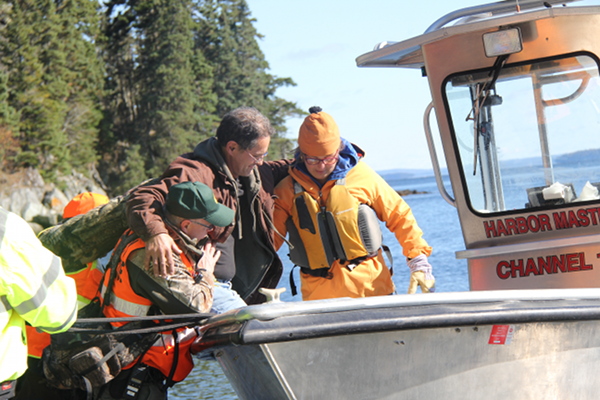
Waldo County Search and Rescue (SAR) member Jeff Grass in orange vest and Harbormaster Abbie Leonard in yellow assist “victim volunteer” Steve Hadsell onto the Rockport Harbormaster boat for transport to the mainland. Laselle is a privately owned island in Penobscot Bay and previous site of a real wild fire that could have burned millions of dollars worth of property but for the quick response of emergency crews. – Photo by Kate Hotchkiss Taylor
Says Knox County Emergency Management Agency (KXEMA) Director Ray Sisk, one of the lead coordinators of the event, “We intended to take responders out of their comfort zones. For example, EMS personnel from the mainland were not working from their customary ambulances and near-immediate mainland support; Island responders, used to working in more austere environments and in many cases alone, had diverse response elements and less familiar faces to work with.”
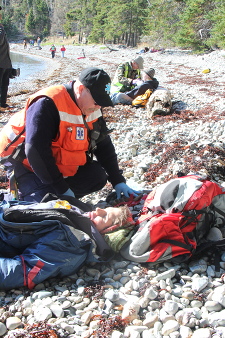
In addition to being out of their comfort zones professionally out to sea on a Maine island, victims and first responders fought brutally cold temperatures and searing winds on an unusually cold October day. Here Midcoast SAR’s (MCSAR) Elliot Scott treats “victim” Jada Beardsley while MCSAR’s Clarence Spady treats “victim” Robin Clay. Most of the land-based victim actors are volunteers from the Ragged Mountain Ski Patrol. –Photo by Kate Hotchkiss Taylor
Says Sisk, “In a Unified Command, primary agencies, each having a statutory authority or jurisdictional obligation, band together into one single “unit” speaking with a single voice. [This] allows each agency to meet their responsibilities in the most effective and efficient manner possible.”
For this day’s island emergency response training session, an imaginary plane crash results in fifteen people in the type of life-threatening danger when every moment counts. Four Maine State Police Dive Team victim actors, in protective wetsuits, wait offshore for rescue. They are saved several times for good measure and practice. Eleven additional actors, including one local commissioner and the Ragged Mountain Ski Patrol “made it” to land the night before, eight of them scattered along the eastside beach including a “pregnant” woman, two in a hole in adjacent woods they had fallen into searching for help, and one bloodied survivor separated from the rest on the west side of the island. The immediate patients have simulated hypothermia and injuries ranging from a severed hand to internal bleeding, leg injuries, cuts, and bruises. First responders landing on the island via the Maine Marine Patrol’s P/V Guardian must regroup and traverse the island to find and treat the victims.
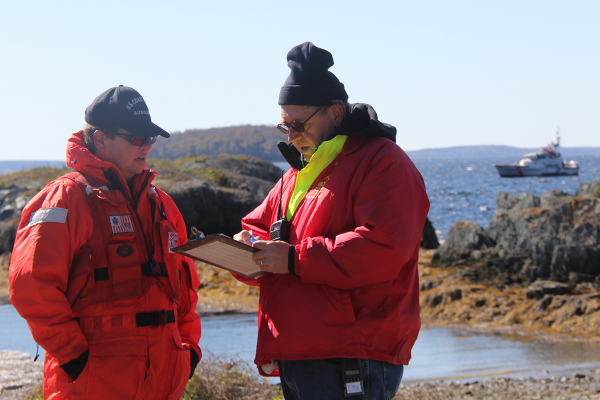
Coast Guard Auxiliarist Kevin Taylor, on the left in orange coveralls, reviews personnel accountability with island controller Kyle Santheson of the Waldoboro EMA, while the US Coast Guard stands by. –Photo by Kate Hotchkiss Taylor
Island rescue training is not easy or idyllic. For example, responders initially walk pass a bloody-faced victim hidden between two buildings where she had collapsed “unconscious”, protected from the piercing wind that rips through the island. Upon discovering the eight injured along the beach, emergency personnel must triage-assess and treat each patient, and then quickly get them off island in order of the most life-threatening injury – an exercise that takes medical expertise as well as on and off island communication. Victim-actors memorize
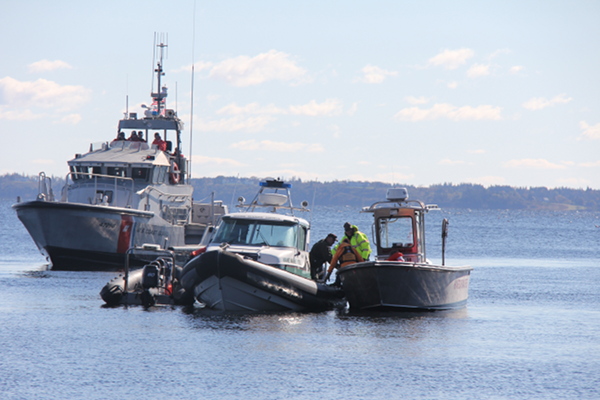
(L to R) Crew from the on scene commander USCG Motor lifeboat 47256, a small inflatable from Maine Marine Patrol (MMP) P/V Guardian III, the MMP Protector; and the Rockport Harbormaster boat all contribute to the search and rescue operation involving 15 victim-actors and nearly 30 organizations. – Photo by Kate Hotchkiss Taylor
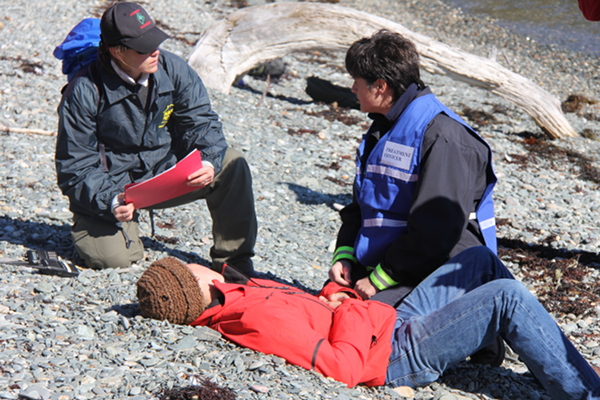
Maine Forest Service Ranger Alicia Black (left) evaluates care of bruised and battered Meredith Currier by Brooks Ambulance treatment officer Mikka Pelletier. Through observations of and questions to first responders Black also determines how well the communication between agencies is working. – Photo by Kate Hotchkiss Taylor
The main difference between the emergency exercise and the real thing is responder adrenaline levels and some treatment simulations: For example, victim Robin Clay leans against a piece of driftwood and thus initially looks reasonably all right to Midcoast Search and Rescue (MCSAR) member Clarence Spady – except for that bloodied coat sleeve. “There’s blood on your hand,” Spady says, almost casually, “What happened there?”
“I lost my hand,” Clay replies matter-of-factly.
“That changes everything!” Spady exclaims, kicking into professional action, putting a makeshift tourniquet to stem the blood flow using a stick off the beach and bumping her up in the queue to leave the island. Meanwhile, Camden First Aid Association Ellie Adams whispers pointers into Clay’s ear about how to react to the responder and personal condition, given she is laying on the beach with a severed limb, she swam to shore the night before, and is now sitting on a pile of seaweed in well below freezing air temperatures. After all, this victim’s patient scenario card includes “wet clothing”, “loss of coordination”, “exhausted”, and “shivering violently”.
Whether the injury is a missing hand or something less serious, since the medical responders know the fake-injured are not really going to die that morning, stress is considerably lower than the real deal. Personal clothing is saved as well: A woman portraying a man with a severe gash to the leg and potential spinal injuries is spared having her jeans cut off in sub-freezing temperatures, something EMTs sometimes need to do in a true medical crisis to prevent spinal injuries resulting in paralysis.
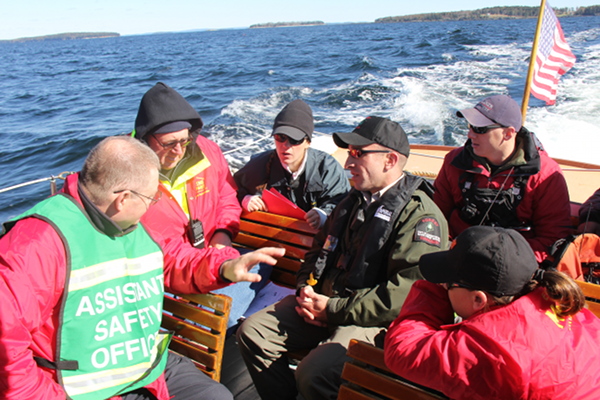
Controllers and evaluators review island response after the exercise onboard Camden’s M/V Betselma captained by Les Bex. (l to r) Cape Elizabeth Fire’s Jim Frasier, Waldoboro EMA’s Kyle Santheson, Maine Forest Rangers Alicia Black and Scott Maddox, Gardiner Fire’s Andrew Santheson, and Camden First Aid Association’s Ellie Adams
Exercise support from the Department of Homeland Security via the State Exercise Program and donations of volunteer time helped mitigate the cost of this training, which could save lives in the future. Equipment was donated as well, including a life raft from air taxi service Penobscot Island Air (PIA). Along with Life Flight of Maine, PIA evacuates injured and emergency level sick off islands at a moment’s notice.
Of this day’s exercise, one that involved a greater-than-typical emergency, Dale Rowley observes, “There were a lot of things that could have been done a lot better, but that is why we drill. Test the plan, improve the process, update the plan and try again.”
Adds Ray Sisk, “This exercise experience serves us well for any number of actual incident scenarios which could occur generally along the coast of Maine and specifically in Penobscot Bay.”
In very sad fact, less than a month later the skills honed on Laselle Island helped coordinate an immediate response to a land based plane crash at Owl’s Head. Three young men died on impact in that crash. Observes Sisk, “Tragically, there was nothing the first responders could have done to alter the outcome, but it was clear they employed many of the skills reinforced through their prior exercise activity.”
Adds Ellie Adams, echoing how we all feel about accidents, particularly those as extensive and multi-layered as the one trained for on October 13th, “Hopefully an incident like the one portrayed in the exercise that day never occurs, but if it does happen it is good to know we have trained personnel and resources available that will be needed to make such a large scale operation a success.”
Links:
Reporting Island Fires
Lasell Island Fire








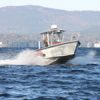


COMMENTS
There are no comments yet!